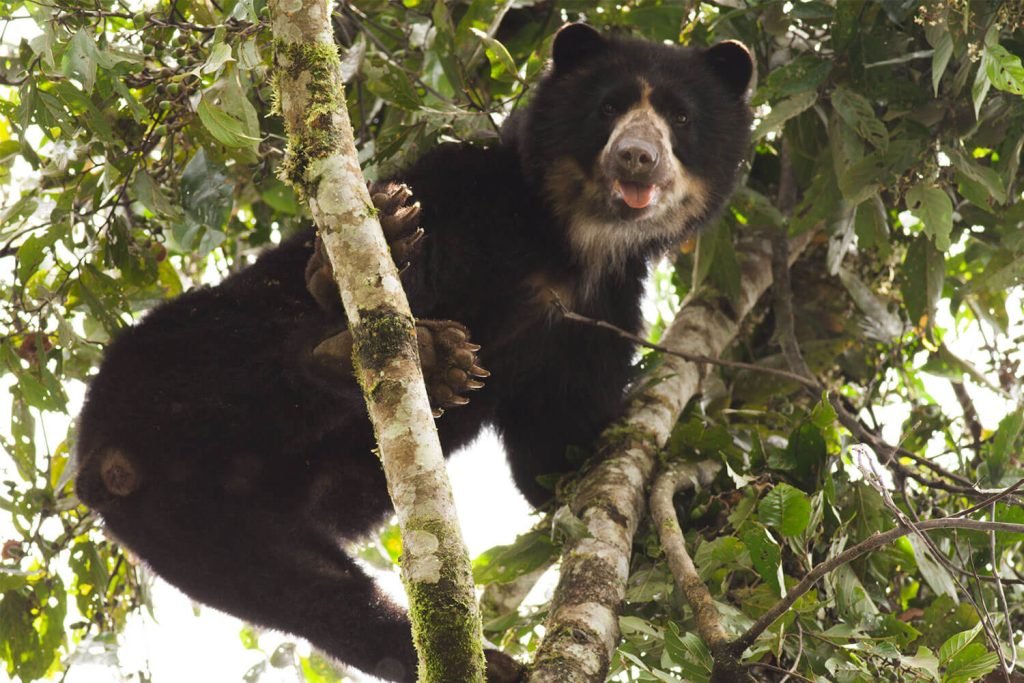Spectacled bears, also known as Andean bears, have a very varied diet. Their diet consists mainly of fruits, vegetables, insects and small vertebrates. These animals are specialized in climbing trees, which allows them to reach different food sources.
An important part of the spectacled bear’s diet consists of fruits, such as bromeliads, berries, cacti and some tree species. They have a special preference for sweet and juicy fruits and feed on them when they are available in their habitat. Fruit is a rich source of nutrients and energy for these animals.
In addition to fruit, spectacled bears supplement their diet with various vegetables. They consume shoots, leaves, roots and bark, taking advantage of the nutrients from these plant sources. This part of their diet is especially important during the months when fruit is scarce.
Insects are also part of the diet of spectacled bears. They are adept at finding ants, termites and other insects in tree trunks and on the ground. These animals have strong, sharp claws that allow them to dismember wood and search for insects hidden inside. Spectacled bears can also eat larvae, worms and other small invertebrates they find in their environment.
In addition, spectacled bears occasionally feed on small vertebrates such as rodents, birds and even eggs. This part of their diet provides essential protein for their nutrition, although it is not their main source of food.
The availability of different types of food may vary according to season and geographic location. Spectacled bears are adaptable animals and able to adjust their diet as needed, exploiting the different food resources in their environment.
In short, spectacled bears have a varied diet, consisting mainly of fruits, vegetables, insects and small vertebrates. These animals are specialized in climbing trees, which allows them to access various food sources. Their varied diet is fundamental for their survival and reproduction in the mountains of Peru and other regions where they are found.
What is the breeding season for spectacled bears?

The breeding season for spectacled bears varies slightly depending on the region in which they live, but generally takes place between April and July. During this period, males enter into a state of competition to attract females.
Males seek receptive females and compete with each other for the right to mate. These competitions may involve physical confrontations, such as displays of strength and vocalizations characteristic of spectacled bears.
Once the male has won the right to mate, he approaches the female and mating occurs. After mating, the female goes through a gestation period that lasts an average of 6 to 8 months.
Spectacled bear cubs are usually born between November and February. Females usually give birth to one or two cubs, which are born blind and completely dependent on their mother. The cubs are very small and vulnerable at birth, weighing between 300 and 400 grams.
During the first months of life, the cubs remain close to their mother, feeding on her milk and receiving maternal care. The mother is extremely protective and devoted to her cubs, providing them with warmth, protection and food.
The cubs remain with their mothers for approximately one year, during which time they learn essential survival skills, such as foraging and climbing trees. After this period, the cubs become independent and separate from their mother to start their own lives.
In summary, the breeding season for spectacled bears is usually between April and July. The cubs are born between November and February and are cared for and protected by their mother for approximately one year. This critical phase of the reproductive cycle is essential for the continuity of the species and to guarantee the future of these incredible animals in the mountains of Peru and other areas where they are found.
Where spectacled bears are born

The cubs of the spectacled bear, known scientifically as Tremarctos ornatus, are born in protected shelters, usually called dens. The mother builds these dens, which provide a safe and cozy environment for the birth and first months of life of the cubs.
The dens can be found in a variety of places, such as caves, tree hollows, dense bushes or even in the middle of rocks. The choice of location varies according to availability and the characteristics of the environment in which the female lives.
These burrows are carefully selected to protect them from the natural elements, such as wind, rain and cold. In addition, these shelters help keep the cubs warm and safe from potential predators.
The mother bear prepares the den with materials she finds in nature, such as leaves, twigs and grass, creating a soft, thermally insulated environment. This cozy nest is essential to ensure the comfort of the cubs during their first days and weeks of life.
After birth, the cubs remain in the den with their mother for a variable period of time, usually a few weeks. During this time, the cubs are nursed by their mother, grow and gain strength before they begin to explore the outside world.
As they grow, the mother encourages them to leave the den and explore their environment. This process is critical to the development of their survival skills, such as foraging for food and climbing trees.
Burrows are vital places for the birth and growth of spectacled bear cubs. They provide a safe and secure environment, allowing the cubs to grow and develop before venturing into the outside world.
In short, spectacled bear cubs are born in protected shelters called dens. These dens are built by the mother and provide a safe and nurturing environment for the birth and first months of life of the cubs.





